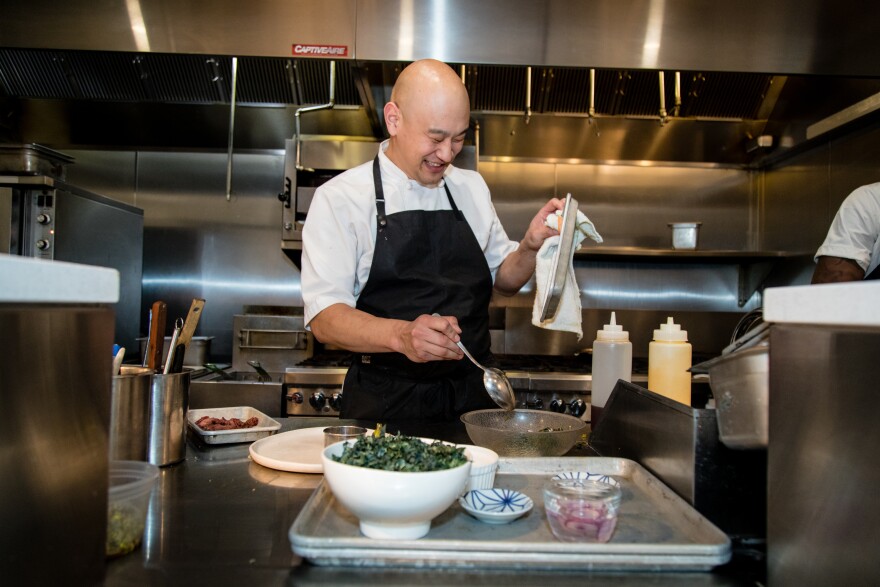Where other chefs might see kitchen trash, Tim Ma finds treasure — for his culinary creations, and his bottom line.
In Ma's kitchen at his popular Washington, D.C., restaurant, Kyirisan, sea bass filets are served to diners, the bones becoming the basis for stocks while the heads might be deep fried and served as an off-menu item. Carrot tops aren't tossed out — they're blended with sautéed garlic, oil, water, basil, parsley, pistachios and scallions to make a creamy pesto. Carrot peels are recycled, too — fried into thin strips that become a crunchy garnish. Tough kale stalks might be braised, then fried for more texture and tossed into a salad with pickled shallots, radishes and duck confit.

"I'm in this fine-dining world, but I spend a lot of time going through my garbage," jokes Ma.
The goal, he says, is not just to show off his culinary creativity, but to fight food waste — and boost his profit margins. "Food waste and food cost are everyday money things," he says. "We're still learning every day how to be smarter about it. We always look at something and think, oh, I don't want to throw that away. How can I use that in something? And I'd say seven out of 10 times, you can't use that. And the other times, you have to get really creative."
Indeed, one of Ma's signature dishes — crème fraiche chicken wings with with gochujang (Korean red pepper paste) and sour sudachi juice — was born of this clever conservation. Ma says he used to take the wings left over from the whole chickens he'd order at his previous restaurant, then slather them with his own concoction and serve them to restaurant staff. The wings proved so popular, they ended up on his menu — though Ma was reluctant at first. "I was like, 'I don't want to put wings on my menu. What's next, loaded potato skins?'" he jokes.

In recent years, it's become almost chic for chefs to fight food waste. About a third of all food produced in the U.S. is tossed out. It's not only a waste of all the water, energy and other resources that went into growing food, but as these edibles decompose in landfills, they release the powerful greenhouse gas methane.
From Dan Barber's WastED pop-up event, which transformed food scraps into a $15-a-plate feast, to Massimo Bottura's efforts to re-purpose surplus ingredients into meals for the hungry, to Anthony Bourdain's documentary Wasted: The Story of Food Waste, many in the culinary world have begun to sound the clarion about the environmental repercussions of this prodigality.
But Ma says there's also a strong economic argument for chefs to cut down on squandered food. "At the end of the day, it's a business decision," he says. "You do this as a function of saving every penny that you can, because the restaurant margins are so slim right now."

Ma adopted his thrifty ways in the kitchen after his first restaurant, Virginia-based Maple Ave, nearly went under a few months after opening. That prompted him to find ways to pinch pennies anywhere he could. Among the changes he implemented: Instead of ordering food items in bulk from large distributors with minimum orders, he sought out local purveyors who would sell him just the amounts he needed. "I can get one head of cauliflower if I needed to," he says, whereas before, he might've felt obliged to order a whole case of it, even if half might end up going to waste.
A former electrical engineer, Ma says he's analytical by nature. He says he spends a lot of his time taking mental inventory of the food on hand. "I walk through the restaurant and see, this is what I have and I think about tomorrow and today. How much of something do I really need?"
That kind of frugality is especially important now, he says: Food prices are rising, but the amount that chefs can charge diners for a plate has stayed the same. "I don't go above $30, but there are a lot of dishes here that cost a lot more [to produce] than a $30 dish should."
Ma says he hasn't calculated exactly how much his waste-not philosophy has boosted his profits, but a new report by the World Resources Institute and the food waste reduction organization WRAP spells out the business case for professional kitchens.
The report uses data from 42 hotel sites in 15 countries that have implemented waste-reduction strategies — from finding ways to re-purpose kitchen scraps and working with suppliers (like Ma has done) to allow for more flexible ordering for perishable foods, to using a smart scale system to measure and categorize their kitchen waste.

For every dollar invested in cutting down on food waste, these hotel–based restaurants saw a $7 return on average, the report found. Researchers are currently crunching the numbers on another study that looks specifically at traditional restaurants, and while the final figures aren't in, the cost-benefit ratio should be in the same range, says Liz Goodwin, a senior fellow and director of food loss and waste at WRI.
Chefs like Ma have a "very important role" in fighting food waste, Goodwin says, "because they are leaders in their kitchen and set the tone and style. It's good for their business, it's good for making their kitchen as profitable as it can be."
"But it's also good for their staff," she says, "because staff feel they're working somewhere that's responsible. And I think it's also good for customers, because customers feel as though they're visiting somewhere that's acting responsibly. So I think there are lots of benefits, quite apart from the environmental benefits. In a way, why wouldn't you do it?"
Copyright 2021 NPR. To see more, visit https://www.npr.org.






